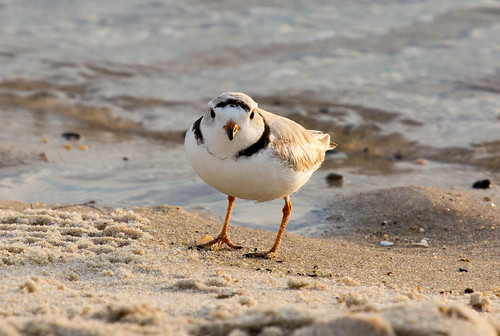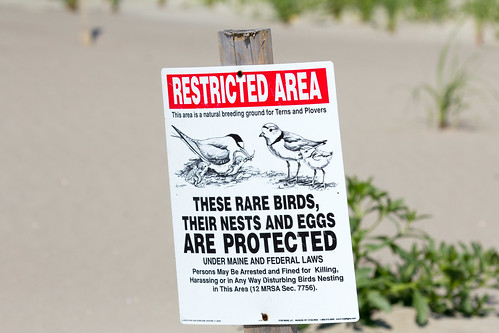
I have lots of friends who occasionally bird with their dogs, but few who take their dogs just about everywhere. There are some excellent birding spots where dogs are forbidden, particularly on beaches where Piping or Snowy Plovers nest. If we lived in a culture where dogs were expected to be well-trained and under control, on- or off-leash, and where people understood and appreciated local wildlife and the problems they face, dogs would probably be allowed even on those beaches, at least on-leash.

When I was in Vancouver this fall, I spent three mornings walking along beaches. One of them was marked as an off-leash dog park, but even where signs clearly stated that dogs were not allowed at all, people were running them on the beach, and even allowing them to chase flocks of shorebirds on the sand and water birds in the shallow water. Several times right when I was photographing a bird, suddenly a dog charged in and chased it off. This is a minor inconvenience for me. But for the birds, it was not just cosmically rude—it was potentially dangerous. In our increasingly developed world, especially along shorelines, there are so few remaining places where birds can come down after a long flight, and where they can find adequate and safe food supplies. Unfortunately, when most people see a bird, they don't see a living breathing entity, much less a sentient one. For them, birds are fun playthings for their dogs (or sometimes their cats!), with no value or rights.
So, obviously, the first rule for a good birding dog is:
#1. No chasing birds!How do you train a dog not to do what seems "natural"? It's best to start with a breed that wasn't specifically bred for chasing prey or chasing other dogs. If you start with a terrier or sled dog breed, you've already got the deck stacked against success. Oddly enough, bird-hunting pointers and retrievers often make splendid birding dogs. They were bred to stop and wait when they do find a bird on their own, and when they pick it up, to bring it straight to their human and give it up. So they are already bred to be compliant and master their deepest instincts. My golden retriever Bunter made a splendid birding dog for that reason. My bichon frise Photon was also a splendid birding dog. Her breed was specifically bred for circus performance. Other related breeds that excel in agility events, in which they pay special attention to their owner's commands, are also easy to train with regard to chasing.
The second rule is to:
#2. Enjoy long walks.This comes natural to most dogs, but a few individuals, especially in smaller breeds, don't enjoy walking much. That wouldn't work in a birding dog. I do a lot of birding on foot, and particularly enjoy birding hikes of 8-12 miles. It's important to provide fun experiences outdoors from the start. Walking and enjoying the outdoors--including in rain and snow sometimes--is essential. But NO puppies should be expected to walk very far as their bones are developing, even if their bodies want to keep going. Slowly building up distance in the first year is the goal.
Even my exceedingly well-trained golden retriever and my perfect little bird dog Photon occasionally had a strong temptation to chase a deer or mosey off sniffing along some fascinating trail. So I always kept them on leash while birding. I need two hands to deal with my camera and binoculars, so on birding adventures, I use a retractable leash with the handle hooked by a carabiner to my belt.
There are times, like along dangerous highways, when staying on heel is essential. Otherwise, I just want my dog nearby where we're both able to enjoy ourselves. Walking along country roads and trails, I always let the dog go a bit ahead or behind, sniffing at a whole world of things I don't have a clue about, but if I hear a bird up ahead and want to hurry, I need the dog to keep up with me. And if I'm watching a bird right there, I don't want to be jerked from where I'm standing. I start teaching good manners on a leash while the puppy is little, using a regular leash at first. The important thing for the puppy to learn isn't to keep a proper heel, but simply:
#3. Don't pull on the leash.A good birding dog comes to a lot of places besides lovely parks. We encounter people and dogs. It's important for the puppy to learn another essential rule:
#4. Never ever lunge at or jump on people or other dogs.Happy little dogs often become barkers. Many people can't help but baby a small, adorable puppy, thinking those little barks are so cute! That is, until they become incessant yaps, but by that time it's too late. So from the start, I always praise my puppy for alerting me to something with one bark. "Good bark!" But then if I hear a second or third bark, it's, "Uh uh. You already told me about that." Usually at that point, I quickly pick up the puppy and distract it with something else. If the barking continues, I just gently pinch a wad of fur on the scruff of the neck, where a mother dog would nip a naughty puppy. The puppies I've had, of compliant, easily-trained breeds, took even the gentlest pinch as a warning, so I never had to do anything more severe to train a dog to follow this rule:
#5. Don't bark.
#6. (Suggested by Ron Holland) Be well behaved in motel rooms, even if left alone while the human birder goes places where dogs are not allowed or where it might be dangerous for a dog.
*****
Birders, of course, have their own rules to follow when bringing along a dog.#1. Clean up after your dog. Every time.
#2. Follow ALL posted rules for dog owners.
#3. Be patient. It's not fun for a puppy or dog to stand still while you tease out the warblers and vireos in a flock. On days when the puppy has to wait patiently for you, give the puppy some extra time to check out what she finds interesting.
#4. Don't forget water and treats.
#5. Pay attention to weather conditions with the puppy in mind. Don't overdo it when it's hot, be careful of the dog's feet on sidewalks where salt was spread, and provide outerwear when necessary to keep the dog warm enough.
#6. Pay attention to nearby animals to make sure they won't hurt your dog.Please post a comment if you have suggestions for other rules for birders or their birding dogs.
No comments:
Post a Comment
Note: Only a member of this blog may post a comment.